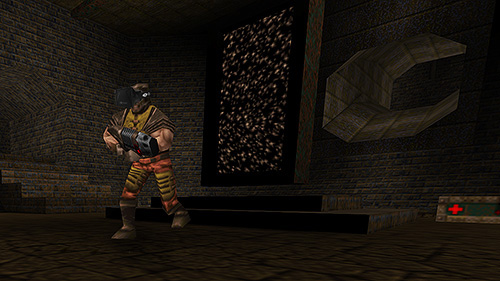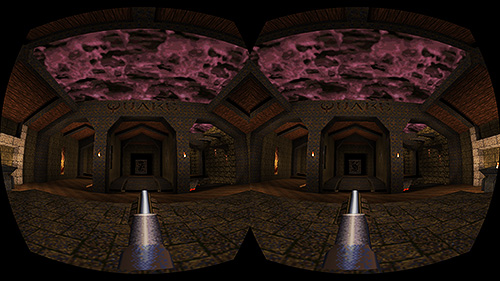Quake for Oculus Rift
With the many "modern" games like Half-Life 2 and Doom 3 already modified to support the Oculus Rift, I decided to give one of my favorite classic games a shot: the original Quake.

Id Software long ago released the full Source Code of Quake under the GPL license. It has been ported to virtually every hardware platform in existence by the community and is still maintaned and kept up to date by several Open Source projects. One of them is the excellent Quakespasm - it aims to be faithful to the original with no changes to the gameplay but tons of smaller improvements and bugfixes. It's built on top of SDL, so it runs on Windows, OSX and Linux.
Quakespasm provided a nice and clean starting point to implement support for the Rift. It's evident that Quake's C source code has a radically different style than John Carmack's later games, with almost all data stored in global variables and tons of functions with no arguments. Still, the source is very straight forward and easily understandable. I had almost no problems implementing the Rift support, but in the end took quite a few shortcuts with some dirty hacks.
All in all, it works really well with the Rift. Quake feels even grittier and darker than it ever did before. The textures are pretty coarse and you can count the polygons on the enemies by hand, but it all comes together so nicely when you run through the corridors, completely immersed in the world with the original Nine Inch Nails soundtrack blasting through your headphones. For me personally, this ended up being one of the most enjoyable Rift experiences.

There are still various problems. Making the UI readable in Rift mode is a single dirty hack, some values for the eye offsets are elaborate guesses and in general this thing could have been implemented a lot cleaner. But as far as I can tell, everything works like it should. I only tried this on Windows; my guess is that it works on OSX as well, but I haven't changed the project files to incorporate the new code.
To enable Rift support, bring up the console (~ key) and type the following:
vr_enabled 1If your Rift is connected, this should be all that's needed to get started. On my system, turning on VSync was a good idea - updates are a bit slower, but less stuttery. There's no tearing without VSync, so I assume that SDL is doing something funky here behind the scenes.
- Quakespasm Rift for Windows - includes Shareware pak0.
- Source code on Github
You can still buy the full game at idsoftware.com or on Steam.
Edit July 6th: I fixed some rendering issues that warped the view. Please re-download.
Edit July 7th: Switched to predicted view orientation and added vr_supersample option.
Edit August 22nd: renamed all cvars to have a vr_ prefix. See the Readme on Github for a list of available cvars.